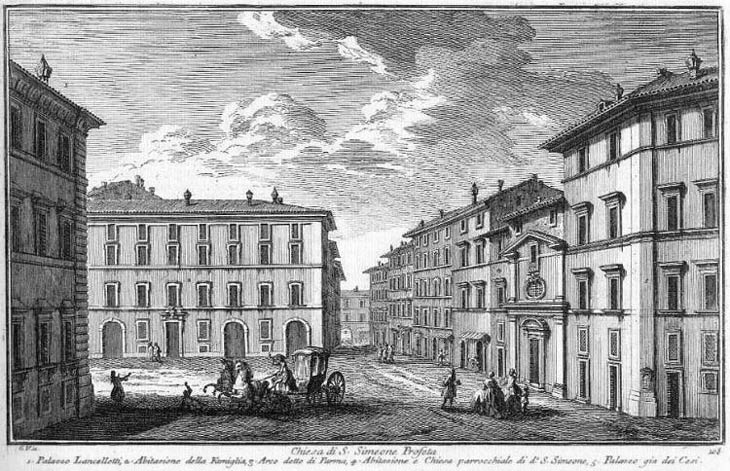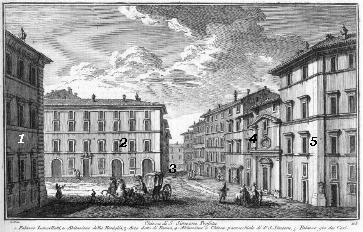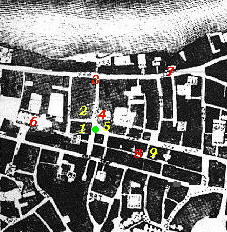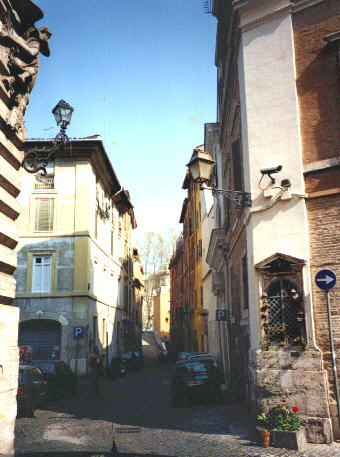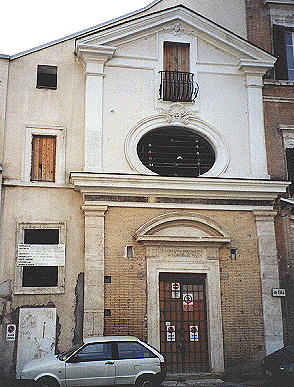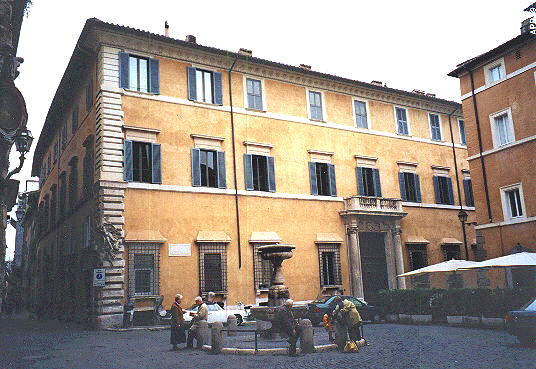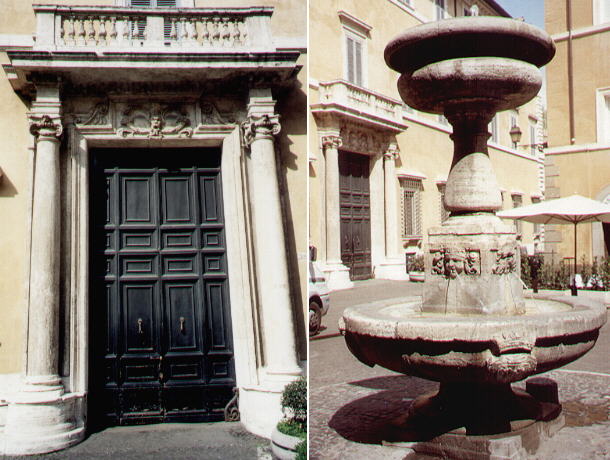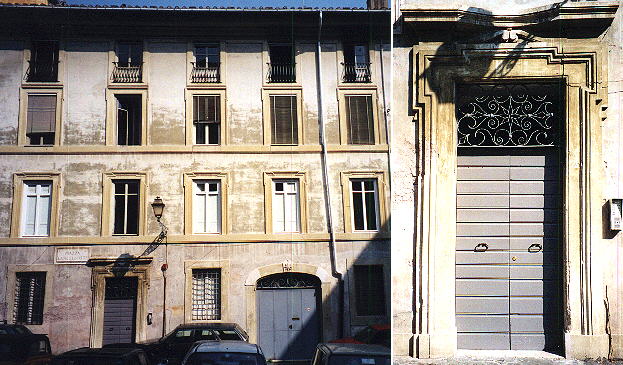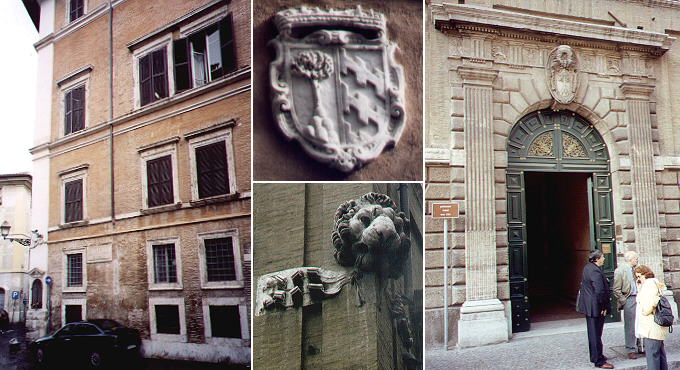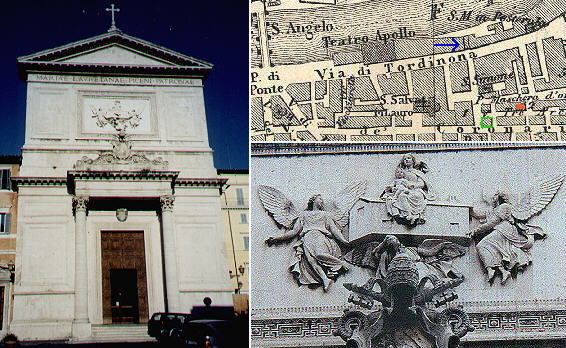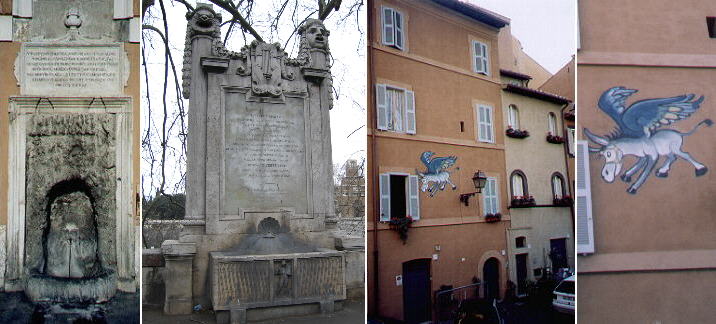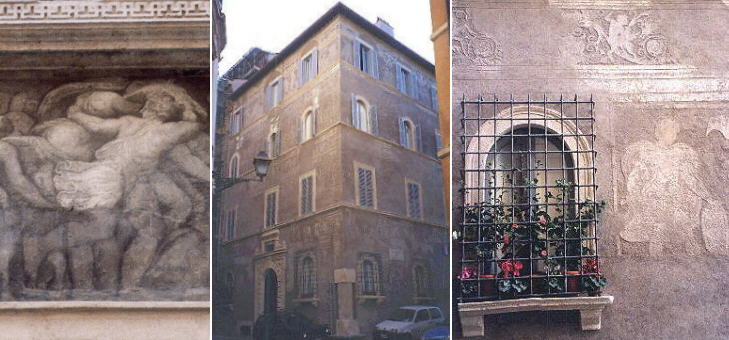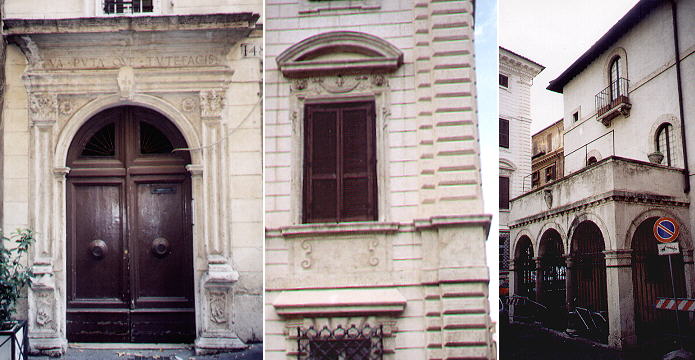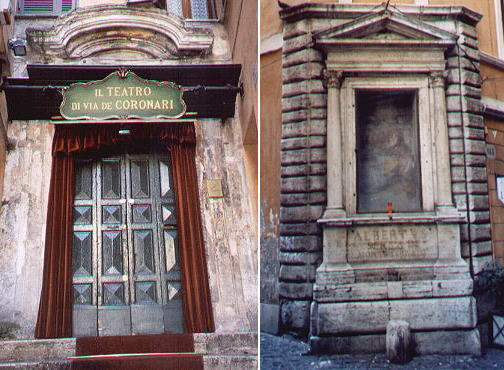  S. Simeone Profeta (Book 6) (Day 4 ) (View C5) (Rione Ponte) In this page:
We are here close to Ponte S. Angelo: Arco
di Parma leads down to the river bank; it was one of the few accesses to
it in this part of Rome. The view is taken from the green dot in the small 1748 map here below.
In the description below the plate Vasi made reference to: 1) Palazzo Lancellotti;
2) Other buildings adjoining Palazzo Lancellotti; 3) Arco di Parma; 4) S. Simeone; 5) Palace once belonging to the Cesi family.
The small map shows also: 6) S. Salvatore in Lauro; 7) S. Maria in Posterula; 8) S. Salvatore in Primicerio; 9) Palazzo della Maschera d'Oro.
The view is not much changed but rather than going down to the river now there are steps going up to the Lungotevere.
The little church of very old origin was entirely rebuilt by Cardinal Girolamo Lancellotti in 1610, mainly to retain a parish church next door to his palace. The fašade is the only remaining part of the church .
The plate shows only a corner of Palazzo Lancellotti which was begun
by Daniele da Volterra and completed by Carlo Maderno. The portal is attributed
to Domenichino. The street to the left of Palazzo Lancellotti is Via dei Coronari, famous today for its antique shops. It was opened by Sixtus IV in the
XVth century to facilitate the access to St Peter's and it was called
Via Recta (straight street). There were many shops selling devotional goods to the pilgrims including rosaries and small crowns (hence Coronari).
The houses for the servants are shown in the plate and they still bear the star of the Lancellotti.
In the first half of the XVIIth century the family Cesi was among the wealthiest families of Rome. Cardinals Donato and Angelo Cesi built the fašade of S. Maria della Vallicella, the duke Federico Cesi protected Galilei, another duke, Francesco Maria, married a niece of Clemens VIII and added to the heraldic symbol of the Cesi (a tree on a mountain) the stripes of the Aldobrandini. At Vasi's time the Cesi had left the palace shown in the plate, but they retained a larger palace near Piazza S. Pietro in what is called today Via della Conciliazione. The palace has a fine XVIth century portal and on a corner a gigantic head of a lion. S. Salvatore in Lauro and Fontana del Leone
The detail of the map shows the location of three churches near Palazzo
Lancellotti. S. Maria in Posterula was a
little church built in a small gate of the walls on the river (posterula
means small gate) and was pulled down at the end of the XIXth century,
together with Arco di Parma (marked with a blue arrow) and Teatro Apollo or Tordinona, one of the main theatres of Rome. Arco di Parma had this name
because of a nearby (lost) palace which belonged to a cardinal who had been bishop of Parma. S.
Salvatore in Primicerio (the red dot in the map) is no longer a church.
S. Salvatore in Lauro is dedicated to our Lady of Loreto (the detail of
the fašade shows the angels bringing the holy house to Loreto) and it is the national church
of the inhabitants of Le Marche the Italian region on the Adriatic Sea which was part of
the Papal state (click here for a list of national churches in Rome). The church
was restored in neoclassical style by Guglielmetti in 1862. The building
with a green border was pulled down to create the square opposite Palazzo
Lancellotti.
Palazzo di Via della Maschera d'Oro
In Via della Maschera d'Oro (Golden Mask) there is a XVIth century palace (Palazzo Milesi) which was painted by Polidoro da Caravaggio, a pupil of Raphael. The subject of the paintings is the myth of Niobe, although many scenes were inspired by the reliefs of Colonna Traiana. The name of the street is due to a detail of the decoration showing a little boy hiding behind a golden mask. Part of the paintings were revived in 2004 (image on the left). Next to it there is another Renaissance building with evidence of graffito paintings and decorations. Renaissance Buildings in Via de' Coronari
Via de' Coronari has several Renaissance buildings worth a short note. The portal of the house of Prospero Mochi was designed in 1516 and it shows some typical elements of Renaissance architecture (the use of the arch, the entablature with a moral inscription, the lateral pillars). Palazzo Ruiz or Sampieri is a Late Renaissance palace attributed to Bartolomeo Ammannati. Casa di Fiammetta is a (much restored) XVth century detached house at the end of Via de' Coronari. Fiammetta is the name of a Florentine courtesan, who was "friendly" with Cesare Borgia, the preferred son of pope Alexander VI, who in turn had been friends with another famous courtesan, Vannozza Cattanei.
SS. Simone e Giuda was also known as S. Maria in Monticello, with a reference a small elevation called
Monte Giordano. The tiny church was deconsecrated at the beginning of the XXth century and turned
into a cinema, then into a restaurant and finally into a theatre. The only thing left is the XVIIIth century portal.
Next plate in Book 6: SS. Celso e Giuliano Next step in Day 4 itinerary: SS. Celso e Giuliano Next step in your tour of Rione Ponte: Palazzo Boncompagni Corcos
Go
to |
All images © 1999 - 2003 by Roberto Piperno. Write to romapip@quipo.it
